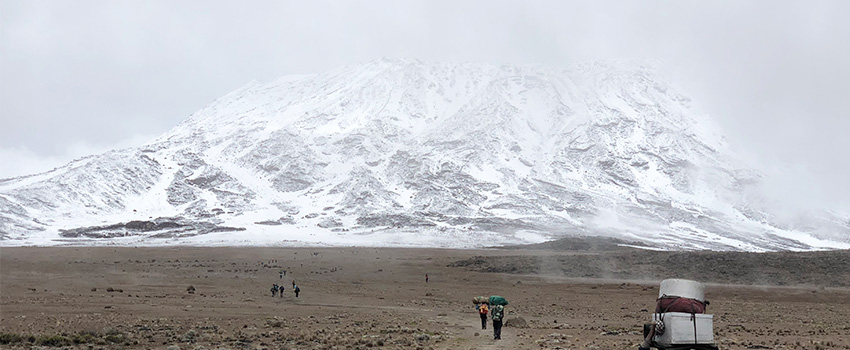By Roland Handel
The wind is so strong, so goddam loud, that I can’t even hear myself gasping for air. My hood flaps and slaps against my face as the wind tries to tear the clothing right off my body. A constant barrage of frozen icy pellets batters my clothing. My nose and cheeks, the only exposed part of my body, sting in the freezing conditions, although both are fast going numb in the biting cold. And all around it is pitch black, save for our headlamps, trying desperately to illuminate the way ahead. But all I can see is a swirling wall of white.
I pull my head further back into my hood. The temperature has plunged below -15C, but with this gale, the windchill must be twice as cold. My headlamp illuminates the two nearest climbers, Christophe (Tophe) and Abraham. They sit slumped in the snow, their hands stuffed into their armpits to stay warm. A little further down the slope I can just make out the three others; Kim, Seraphine and Musa. But the wind whips up the snow so much that they appear as little more than dark shadows. Their headlamps are pointed downward; they, too, are huddled together against the relentless wind.
I’m the only one of our group to remain standing. Sitting down would expend too much energy. Besides, I just want to keep going. What’s the point of just hanging around in this weather? It ain’t getting any better. A pea sized chunk of ice smacks against my sunglasses.
I know there are others on this mountain. Somewhere, out there. But we haven’t seen any other headlamps for a while. I peer up and down the slope. Nothing. How far into these swirling depths could I really see anyway, I wonder? Have we wandered off the trail? Our lead guide, Abraham, seemed to know where we going. But then, how could he really know the way, given the white-out conditions. I guess the only way is up, I resolve. A sudden intense gust of wind unbalances me, and forces me to take step backward to avoid toppling over.
Finally Abraham climbs to his feet. “Time to keep moving,” he yells. Despite being only a few metres away, his voice is quickly is lost, carried away in the wind. The others sluggishly climb to their feet; together we continue our slow progression upward. With nothing to do but inch our way ahead, my mind wanders. Just a few days ago, our adventure had started out in such glorious sunshine.
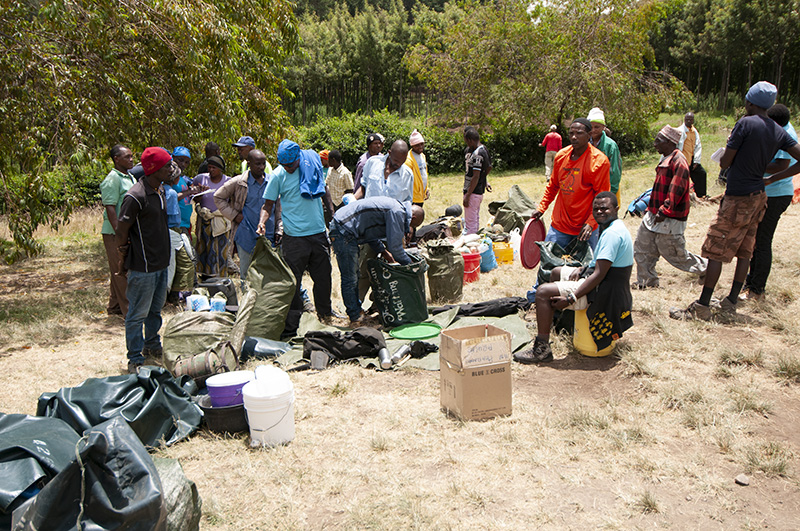
The day before we started our climb, I snapped this pic of Kili. Bathed in sun with just the smallest patch of snow. This would all change in the coming days.
THE ADVENTURE BEGINS
A week earlier, Tophe (a high school buddy), Kim (a friend from university) and I had all arrived separately in the central African nation of Tanzania. Now, we all sat together in a hotel bar at the base of Mount Kilimanjaro—Africa’s highest peak, at 5895m—deep in conversation with Abraham about our impending climb up the mountain. The three of had joined a World Expeditions six-day summit climb of Kili, approaching via the rarely-frequented Rongai Route. I was the group’s least experienced, having never climbed much beyond 4000m. But for the others, too, this climb would take them higher than they’d ever been. Despite having read the climb’s track notes, we still had dozens of unanswered questions to pepper Abraham with.
“How cold will it be on the summit?”
“Will we be able to breathe?”
“Will we suffer a pulmonary edema?”
Abraham responded to our concerns with the calm of a man who’d heard these questions many times before. And he had. At 45 years of age, he’d spent more than half his life working on the mountain. Starting at age 18, he’d worked his way up from porter to cook to assistant guide to lead guide, improving his English and guiding skills along the way. We were at least in safe hands.
At 8am the following morning, we climbed into a 4WD for the two-hour drive to the climb’s actual start. The weather was warm and glorious. We wore shorts and t-shirts, and took photos of the bulbous volcanic summit of Kilimanjaro. Roughly 80% of the mountain’s famed snows have melted over the last century, and its glaciers face extinction. Looking at Kili now—on this balmy day, with the summit bathed in sun and just a small, almost forlorn patch of snow splashed across one slope—there was no reason for us to suspect this unhappy thaw wouldn’t continue. Little did we know.
RONGAI GATE
When we reached Rongai Gate (1910m), our hike’s start, the scene before us wasn’t exactly what I’d expected. A small army (16 to be exact) of porters, cooks and guides were busily sorting, weighing and packing gear for several groups departing at the same time. And then I learnt, no, all this—the pots, pans, gas cylinders, portable toilet, etc, etc—was just for us. Abraham explained that while climbing Kili is possible with far smaller entourages, with Tanzanian unemployment hovering around 70%, locals need the work. It’s lucrative, too; the wages paid during our six-days of hiking roughly equate to several months of paid work elsewhere. It all delivers significant financial benefit to workers’ families. Abraham is a case in point; his wages earned on the mountain allowed all his children to graduate from high school, with two completing university.

All these guides, porters and cooks….just for us!
ACCLIMATISATION
The first few days were uneventful and relatively easy. We first passed through farms—grain, corn and bananas plantations—before entering temperate forest, where monkeys would peer down on us from high in the trees. Eventually the forest gave way to smaller scrubby bushes and then ever-starker moorlands. These early days were short, with just 3-5 hours of actual walking, often at what felt like an excruciatingly slow pace. “Pol-ee, pol-ee” (slowly, slowly) our guides would yell at us as they tried to maximise the time we had for acclimatisation.
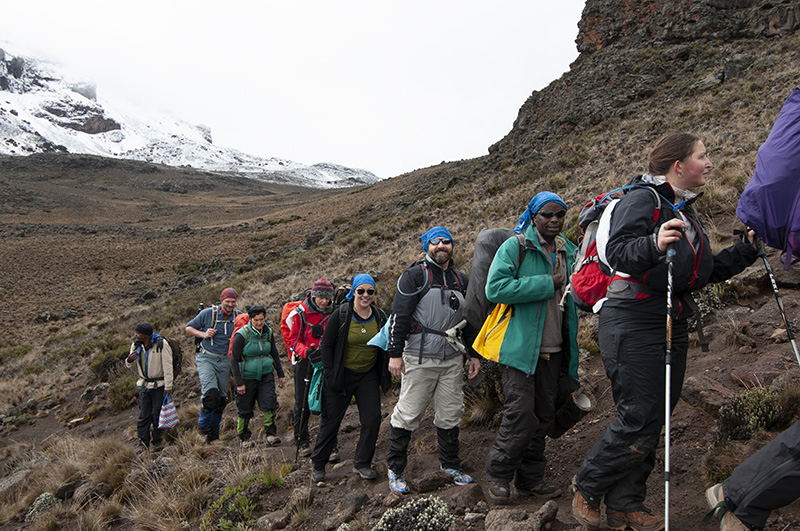
Joining another group as we continue to climb on day two
We climbed above 3500m on our second night, and by our third night at Mawenzei Tarn (4330m) I surpassed my highest previous altitude. The vegetation was now limited to low scrubby bushes and spiky and ragged grasses. Huge swathes of the mountainside were bare dirt and rock. Then the sun disappeared behind the clouds. We never saw her again, at least not until we came off the mountain. The rain started soon after.
Just beyond Mawenzi Tarn, we undertook an additional 300m acclimatisation climb. The altitude was getting to me. By the time we stopped, beneath the stunning Hans Meyer Peak, I thought my head was going to explode. It felt like a hammer was being taken to my temples. Despite the spectacular surrounds, all I could think about was getting to lower ground to ease the unbearable pounding. That night, Abraham suggested I start taking Diamox (a blood thinning tablet that helps alleviate the effects of altitude). Why had I waited so long? By the next morning the headaches had vanished, never to reappear.
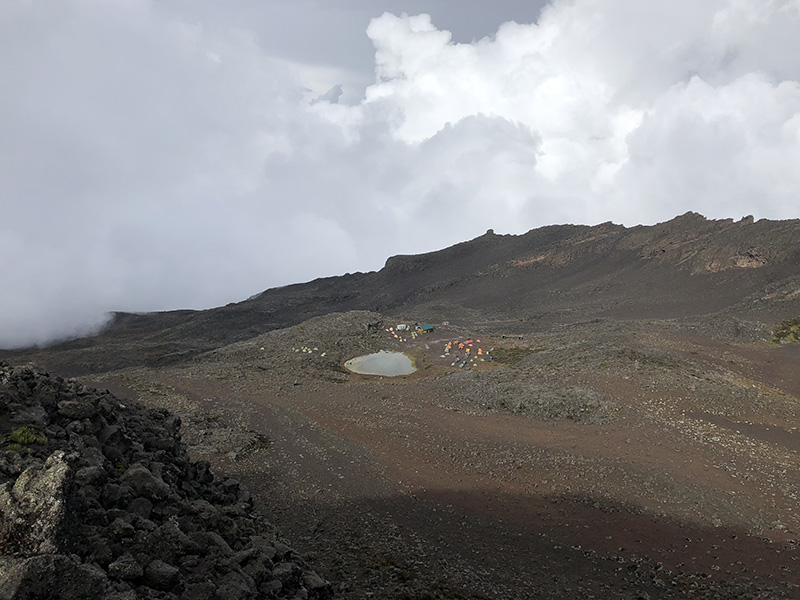
Looking back toward Mawenzi Tarn (4330m)
THE NIGHT BEFORE THE NIGHT
While we amused ourselves around camp at Mwenzi Tarn, the weather worsened. Constant drizzle became a torrent of rain, hail and sleet. Our camp became a labyrinth of small rivers. Mounds of slushy hail piled up on the ground.
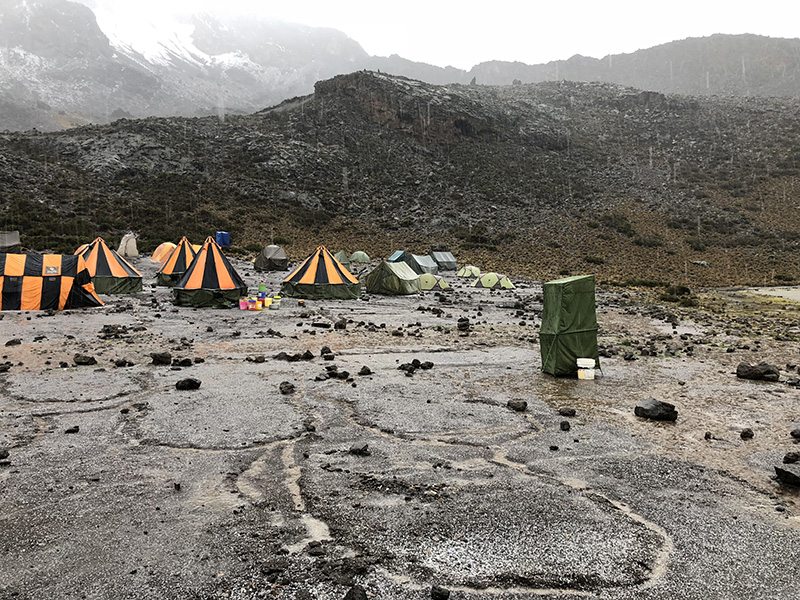
The rain and sleet settles in. Soon after this pic, the entire patch in front of me was white with hail
By morning, conditions improved slightly and we crossed the final stretch of high desert terrain toward Kibo Hut (4700m). By now, all vegetation was gone. We crossed an enormous expanse of volcanic ash, an endless plain that led us toward the base of the final crater. Kibo Hut, nestled among boulders just before the steepest ascent up Kili commences, is where several of the different routes up the mountain all converge. This would be our final rest before our own summit attempt.
That night the three of us met Abraham for a final briefing. He explained that over the previous 24 hours, heavy snow had fallen on the mountain. While we’d slept in our tents at Mzenzi Tarn the night before, thirty or so climbers had set out for the summit; only four made it. The rest were forced back by the wind and snow and bitter cold. Abraham wasn’t sure how we’d fair tonight. We were hikers, not mountain climbers. This meant no-one, including our guides, carried any specialised climbing gear. No crampons. No ice-axes. No ropes.
We returned to our sleeping bags for a few hours of restless sleep, unsure what lay ahead.
THE NIGHT
Just before midnight, my alarm sounded. Even in our protected camp site, sheltered behind a huge boulder, wind battered our tents. I pulled on my down jacket and crawled out into the darkness. Heavy snow was falling. And it wasn’t nice fluffy powder; instead, the snow fell as tiny, wind-blasted ice pellets. It seemed like we were being shot at with a BB gun. We gathered together in a cooking tent for a last gear check. I tried forcing some food down—I’d completely lost my appetite days earlier—before we headed out into the storm.
A few other climbing groups headed out simultaneously; we found ourselves behind a long line of climbers. It was slow going. The path zigzagged up the mountain, although so much snow had already fallen it was difficult to know whether we were even on a path. I simply placed my foot in the footprint of the climber in front and assumed that whoever was at the front knew where they were going. As the minutes dragged into hours, for some of those ahead the wind, the snow, and the altitude simply became too much to endure; a slow but steady trickle of climbers pulled away from the group and turned around.
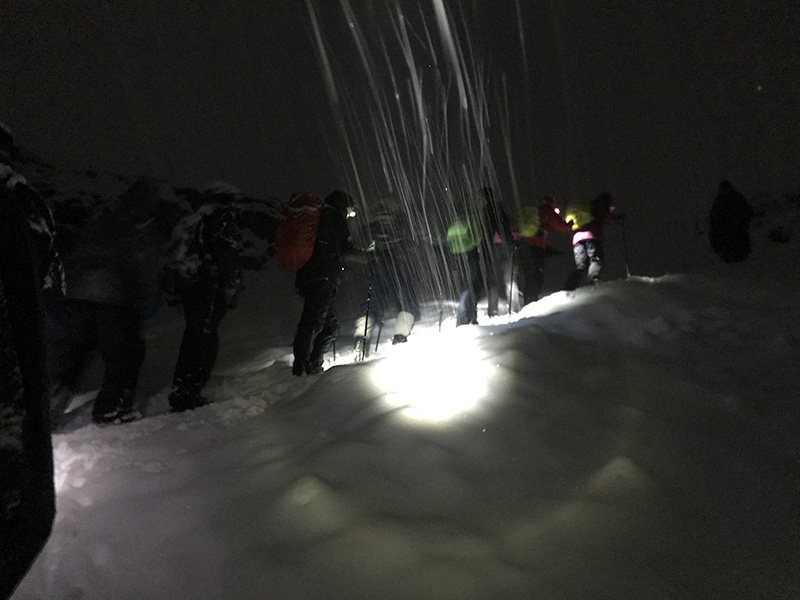
Setting out just after midnight, we follow a line of climbers ahead
We eventually overtook the ever-dwindling group of climbers ahead, and found ourselves ascending alone, at times wading through deep, thigh-burning drifts of snow, at other times slip-sliding our way upwards on slick ice. We moved agonisingly slowly. At one point, I slipped, fell forward, and dug my walking stick in the snow for balance. It snapped clean in half. I was spent. We were all spent.
The wind was screaming now. Even so, even above the wailing maelstrom, I could hear Kim yell, “I f**** can’t f***** see f***** anything!” But she was not alone; none of us could see anything. Our sunglasses—our only eye protection—did little to stop the ice bullets snapping against our faces and eyes.
Someone asked Abraham if we could rest. “No,” shouted Abraham. “No shelter here”. But soon after, he called a halt. Our group slumped to the ground. I was the only one to stay standing—sitting required too much energy.
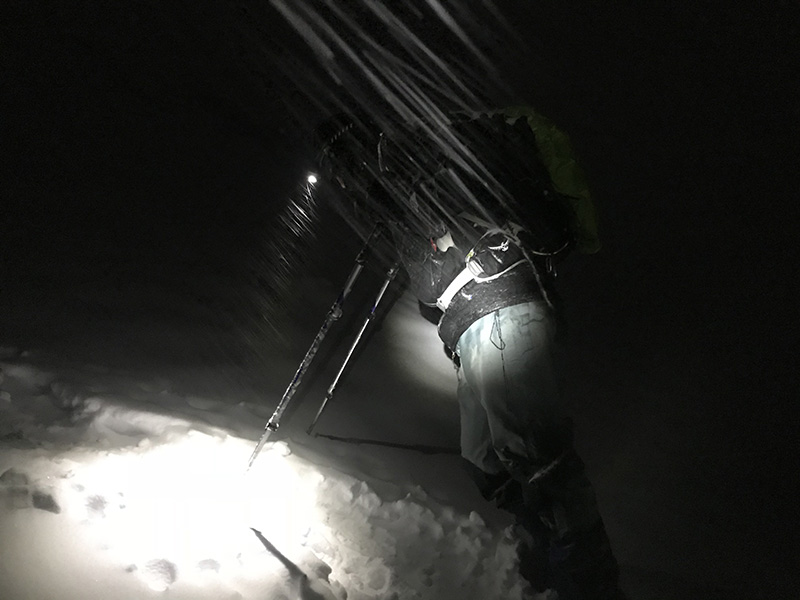
Too exhausted to sit, I use my poles to rest against
GILMAN’S POINT
Finally, the first light of morning arrived, illuminating our surroundings. We still couldn’t see much—everything was a white-out—but the outline of larger boulders started to appear in the swirling snow. Around 8.30am, we climbed a final steep slope and large timber sign loomed before us: Gilman’s Point, 5685m. We’d reached the volcano’s crater.
From here, the summit was just a few kilometres away, a mere 210m in vertical gain. Up here, however, beyond all semblance of protection, the wind raged at new levels. Full of fury, it roared headlong into anyone who dared stand upon the crater rim. Never have I experienced such power and force.
Abraham pointed in the direction of the way forward. I turned to look. The exposed flesh of my face felt like it was being bitten by thousands of ants as icy pellets blasted me. And I couldn’t see a thing. Actually, that’s not true. What I could see was this: the wind literally tearing Musa’s poncho from his body, the shreds of blue nylon disappearing into the swirling snow. Christophe and I retreated behind the sign. Abraham and Musa sought protection lower down, while Kim and Seraphine were yet to reach us.
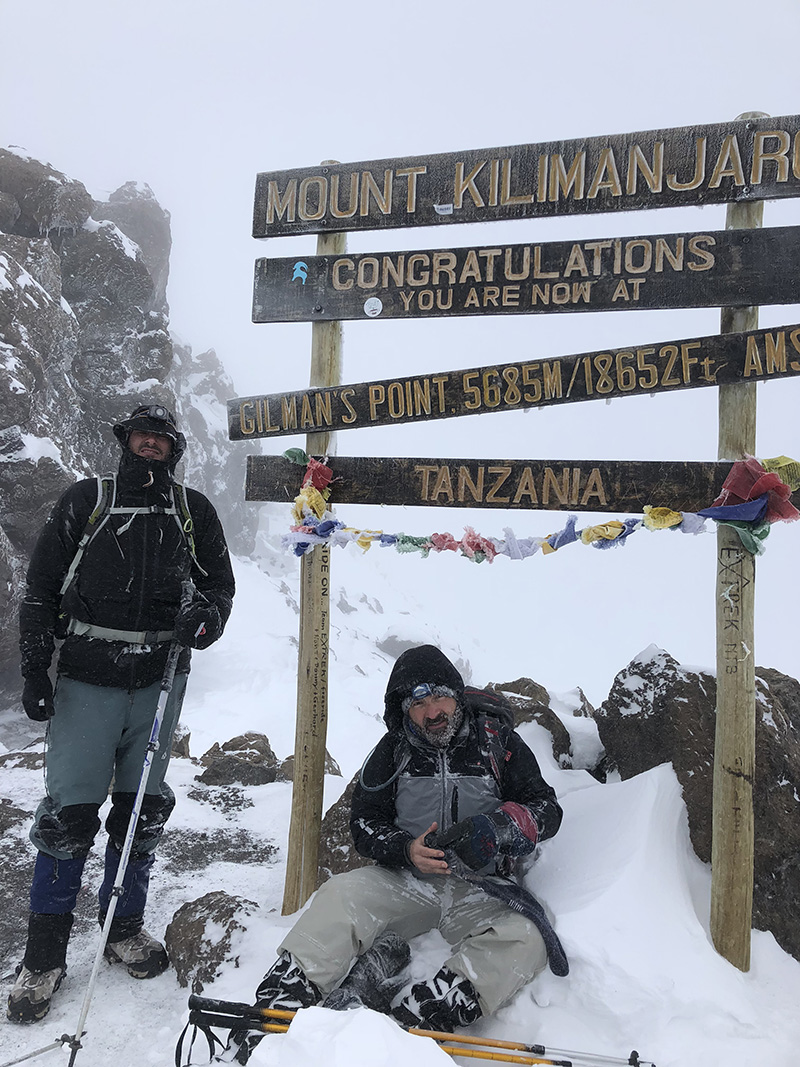
Christophe and I pose for our high-point photo
“Do you want to keep going?” I yelled. I was desperately keen to continue, despite the weather. We’d come all this way; the end was tantalisingly close.
“If you do,” Tophe shouted back.
“This is the worst weather I’ve ever been in,” I screamed.
Tophe just nodded, his head already buried in his jacket.
Another group of two climbers appeared with their guides. They stopped for a few minutes, snapped some photos and then disappeared back off the crater.
When Kim reached us, we all took shelter behind a boulder. I asked Kim if she wanted to keep going.
“No” she said. “I can’t see anything. I’m freezing cold. I’m turning back.”
Abraham seemed torn. He knew I was keen to continue. But he also said there were upcoming sections with considerable exposure. “We don’t have the right gear,” he warned. “No crampons. No ropes.” He went on, explaining that a slip and a tumble could see things become quickly dire, with rescue in these conditions virtually impossible.
And so, at 5680m, the highest I’d ever climbed, we decided to turn back.
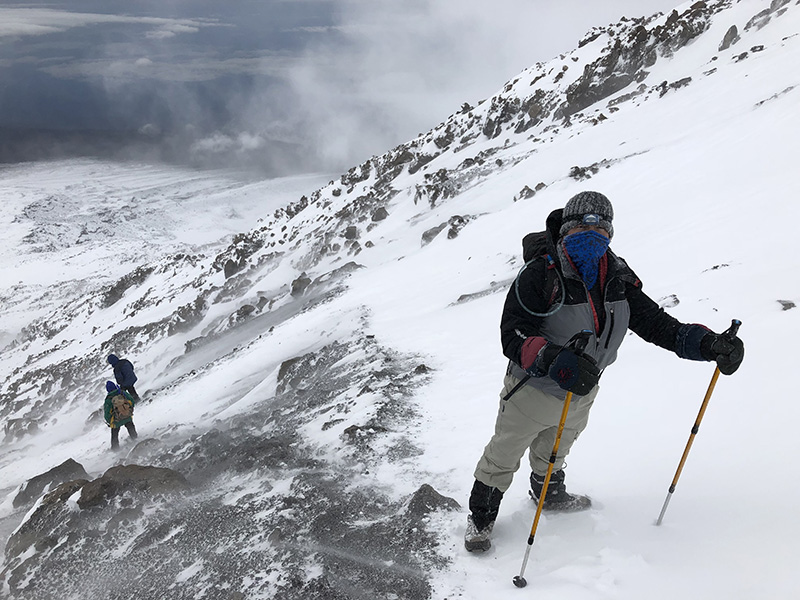
With the weather finally starting to clear, I snapped this Tophe on the way back down the mountain
I knew this was the right decision. As cliché as it sounds, the mountain will always be there. There will always be another day to summit. But deep down, I was shattered. We’d travelled so far to get here – flights, hotels, six days of hiking, thousands of dollars in costs – and now, with the end so near, we were turning back. As we slowly descended, I kept wondering whether we’d (whether I’d) given up too easily. But I reconciled this with the conditions we’d faced. It simply would not have been safe to continue. I’d been in this position before. So close to the end, yet impossibly far. I would have to wait for that other day.
As we spent our last night on the mountain at Horombo Hut (3720m) returning via the Marungu route, we learned that not a single climber at reached the summit that day. Abraham explained that in all his years of guiding, he’d never experienced conditions as bad as we had. Nor could he remember a time when no climbers were able to summit. The weather gods had not been kind. As always, however, they were fickle. The following morning, as we left the mountain, the sun came out and climbers once more were making their way toward Africa’s highest peak.
But for me, when I looked back up, I knew I had unfinished business. One day, I swore, I’d be back to summit Kili.
Wild are returning to Kilimanjaro in 2020
World Expeditions and Wild are returning to Kilimanjaro in January 2020. Join Roland and a limited group of nine climbers, as we attempt to summit Kili via the Lemosho Route. For more details, see the advert in this issue or visit www.worldexpeditions.com/wild


